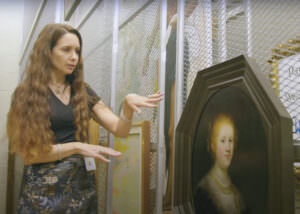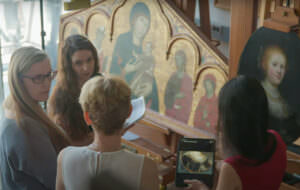In recognition of Women’s History Month, we’re highlighting the women responsible for helping to make Rembrandt Revealed possible. Tune in each week in March to hear from the women behind the exhibition:
Elaine Mehalakes,
Vice President of Curatorial Affairs at the Allentown Art Museum
Greek Cypriot, Vegetarian, Print Geek
How were you involved in making Rembrandt Revealed?
I was the museum’s representative on the conservation of the Rembrandt painting. I had the opportunity to visit the conservation lab at points during the process and consult with the conservators about their recommendations. I also consulted with Rembrandt experts regarding the attribution of Portrait of a Young Woman and put together all of our knowledge of the painting into the exhibition Rembrandt Revealed.
 Who was one of your mentors and what is the biggest lesson you learned from them?
Who was one of your mentors and what is the biggest lesson you learned from them?
As a graduate student, I interned with Mark Pascale, Curator of Prints and Drawings at the Art Institute of Chicago. He trained me in cataloguing works of art and I think that taught me how to really look closely.
What was a moment in your career where you felt exceptionally proud or accomplished?
When I published my first book, American Identities: Twentieth-Century Prints from the Nancy Gray Sherrill, Class of 1954, Collection.
What was one of the most difficult moments in your career and how did you overcome that?
I think the times when I’ve worked as independent curator and writer have been challenging due to the financial insecurity of doing that, the need to drum up work as well as do the work! On the flip side, they sometimes offer opportunities to pursue ideas that you couldn’t when working for an institution.
Name a museum or work of art that you believe every person should see in their life?
The Alhambra in Granada, Spain.
If you could have dinner with one artist (living or non-living), who would it be?
Hieronymous Bosch.
What is your favorite film or book?
One Hundred Poems from the Japanese translated by Kenneth Rexroth.
What is your new quarantine hobby?
I refinished a beautiful driftwood table that my mom had made years ago. My husband, who is a sculptor, helped me with that.
Dorothy Mahon,
Conservator, Department of Paintings Conservation at The Metropolitan Museum of Art
Curious, Patient, Confident
How were you involved in making Rembrandt Revealed?
Dianne Dwyer Modestini, the professor in charge of the Kress Program, called me for consultation when the Allentown Rembrandt arrived for study and treatment. I have had experience studying and conserving paintings by Rembrandt and his school, and a close collaborative relationship has long been maintained between the conservation staff of the Met and the Conservation Center of the Institute of Fine Arts, NYU.
Who was one of your mentors and what is the biggest lesson you learned from them?
John Brealey, the conservator in charge of paintings conservation at the Met, 1975-1989, was my most significant mentor, a relationship which began during an internship in 1977. He emphasized that the conservator’s primary responsibility is first and foremost to respect the work of art from the artist’s point of view.
I also wish to emphasize how significant two women professionals, Dianne Dwyer Modestini and Gisela Helmkampf, were to my education as a practicing conservator. These strong, demanding and talented conservators were members of staff when I arrived at the Met. They generously shared their expertise and challenged me to work to the highest standards. I would not have become the conservator I am today without their important influence and direction. Not enough can be said about how important it is to be set on the right path early in one’s career.

Dorothy Mahon standing next to Elaine Mehalakes, Vice President of Curatorial Affairs at the Allentown Art Museum.
What was a moment in your career where you felt exceptionally proud or accomplished?
The opportunity to participate in studying and preparing the collection for the in-house 1995 exhibition Rembrandt/Not Rembrandt was a momentous period in my career. In addition to paintings by Rembrandt, this project included the study and treatment of many paintings that had entered the collection as Rembrandt, which are now considered by artists trained in his workshop or influenced by Rembrandt. The exhibition was considered a great success and ranks among those with the highest attendance in the Met’s history. Of more personal importance for me was that working on this exhibition made it possible to solidify a deep understanding of the work of Rembrandt and his associates.
In the field of conservation one thing builds on another so, in the intervening years, I have continued to study and conserve Rembrandt. This included the conservation of Rembrandt’s magnificent 1658 self-portrait in The Frick Collection, and the Met’s important self-portrait of 1660.
What was one of the most difficult moments in your career and how did you overcome that?
One of the most difficult moments in my career was when my department head and mentor John Brealey was stricken with an illness that made it impossible for him to continue to work. He was then replaced.
Name a museum or work of art that you believe every person should see in their life?
I feel a visit to the art gallery in Palazzo Doria Pamphilj is not to be missed! This huge 17th century palazzo is on the Via del Corso, in the heart of Rome just steps from the Piazza Venezia. It is still occupied by the family and the possibility of viewing a superb art collection in the grandeur of palatial private rooms is very special. The setting makes the quiet contemplation of Caravaggio’s delectable Rest on the Flight into Egypt an unforgettable experience.
Pope Innocent X was a Pamphilj and the family retains the superb– and a bit scary–portrait that Velázquez painted of this fearsome man in 1650 while he was in Rome. If you go do not miss the family chapel which contains a mummified corps excavated from the catacombs in the 17th century. A letter on display confirms that this powerful family received the permission of the Pope to retain this saint, which, evidently, they brought along for protection when they traveled!
What is your favorite film or book?
My favorite film is Roman Holiday. The 1953 film, starring Audrey Hepburn and Gregory Peck, directed by William Wyler. Rome is a rich and historic city and in addition to the amusing plot and charming acting, it was filmed on location with the scenes taking place in all the major monuments in central Rome. It never ceases to amaze me how little has changed which, as a conservator and avid traveler, I find fantastic!
What is your new quarantine hobby?
My work is my life. The 4 1/2 months I was not permitted to work in the studio provided the time to finish several writing projects for publication. However, working from home did allow more effort to be spent during early spring shaping up the perennial and wildflower garden.
Shan Kuang,
Old Master Painting Conservator, Kress Paintings Program at the Conservation Center at NYU Institute of Fine Arts
Shan Kuang’s role at the conservation center is to treat and research paintings from the Kress collection, including Portrait of a Young Woman. Learn more about the steps she took to preserve the work and reveal the hand of Rembrandt:
Dianne Modestini,
Professor, Kress Paintings Program at the Conservation Center at NYU Institute of Fine Arts
After viewing Portrait of a Young Woman at the Conservation Center, Dianne Modestini discussed the technical mastery and spiritual aspects of Rembrandt’s work:

